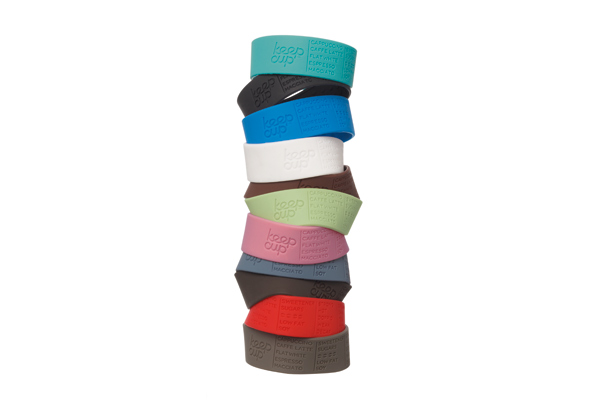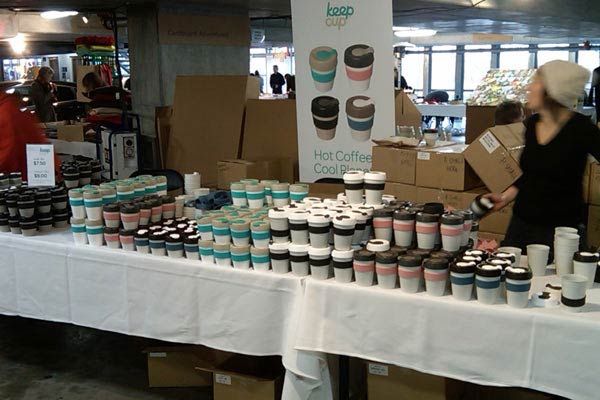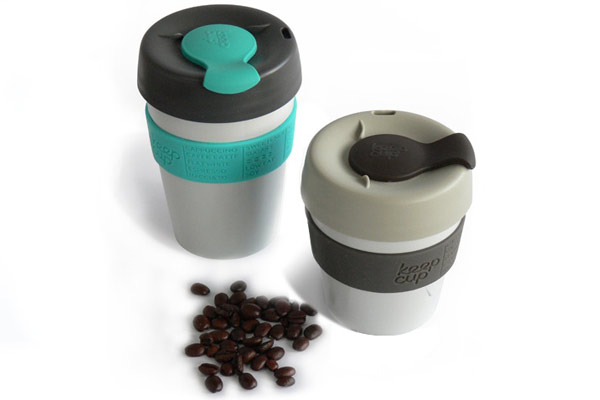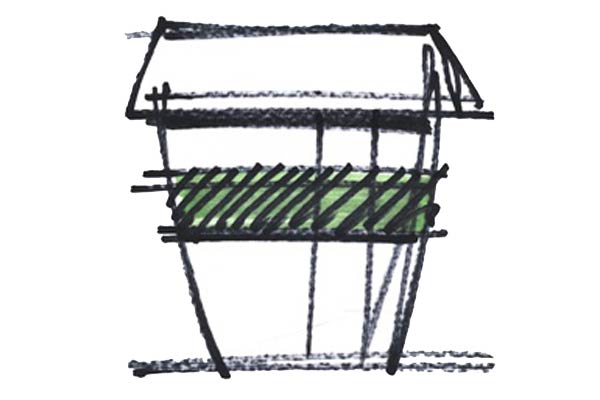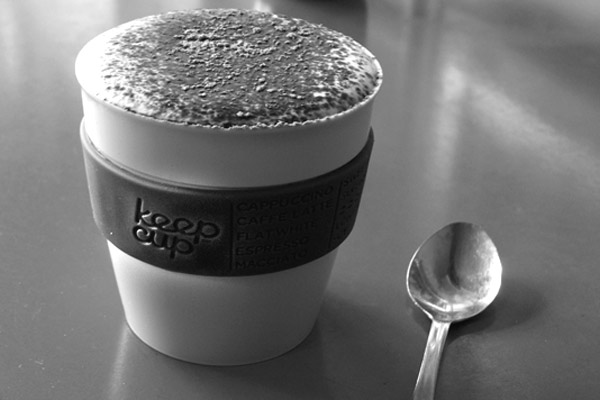KeepCup: Abigail Forsyth
When siblings Abigail and Jamie Forsyth began their first business – a takeaway food store and catering service, Bluebag, in Melbourne’s CBD – they say customers were reluctant to drink coffee from takeaway paper cups. A decade later the Forsyth’s have launched KeepCup, a new business and product they hope will inspire baristas and consumers to bin a bad habit once and for all.
Here Abigail talks with the ADU about the ups and downs of running a sustainable start-up in Australia, and the importance of staying true to the big idea.
Business: KeepCup (2009)
Type of business: Locally designed and manufactured reusable cup
Location: Melbourne, Victoria, Australia
Principals: Abigail Forsyth, Co-Director, and Jame Forsyth, Co-Director
Contact: www.keepcup.com.au
ADU: Can you please describe the business? What is KeepCup?
Abigail Forsyth: KeepCup is the world’s first reusable barista standard takeaway cup and also a wider campaign about the use of disposable goods. The product and campaign were launched on to the market in June 2009.
I had the idea about three or four years ago but it was a big leap to finally say “I am going to do this” because having started a business once before, I knew what was involved and foolishly decided to do it again!
When I had my daughter a few years ago I was working part-time. I would be going out in the day with the pram and I’d carry a takeaway latte and she would be having her milk in a sippy cup and I thought “Wouldn’t that be disgusting if every time I gave her milk, I gave it to her in a paper cup and then threw it away?” It just seemed absolutely ridiculous. That was the moment of clarity.
How long has the cup been in development and who designed it?
The cup has been in development for two years and was designed by Cobalt Niche. But we have been very involved. We presented drawings and drove them bananas basically giving feedback on what we thought.
But because of our hospitality backgrounds, Jamie and I have so much knowledge about how people and baristas would use the cup. We wanted to create something that was user-friendly from the point of view of the end user but also for the people behind the machine. We knew if the barista didn’t like making coffee in them, the idea would flop.
KeepCups are manufactured in Melbourne, was keeping the production local a central part of your business plan?
Yes. It is a real selling point in the Australian market that our product is local. But we also knew it was going to be a difficult tool to manufacture and we would have a lot of liaising back and forth with the manufacturer. Also from an environmental perspective we felt it was important to reduce our air miles.
Is there potential to implement a product stewardship scheme with these cups?
You say on your website that they should last for four years, so in four years do you have a plan for take back?
We made sure the cup was made of single components so it could be recycled in your standard recycling bin, but also looking down the line, this is deep fantasyland now, but my dream is that one day old KeepCups will become new KeepCups and it could become a closed loop production.
However at the moment in Australia we can’t do that, because you have to use virgin plastic to make anything that is food grade. But I think there will come a point when you can wash and then grind and remake.
Can you tell me about the launch of KeepCup on the market?
We had been approaching corporate businesses for twelve months prior to our launch in June. We targeted those who were moving into green star buildings and companies who have a massive environmental footprint like Energy Australia and Qantas.
While all corporates need to do something about sustainability, we approached those who really need to do something visible. A lot of those businesses have been really interested in the cup as a sort of a gift and something that makes very tangible their own efforts.
You launched KeepCup at the Melbourne Design Market in June and also Design Made Trade in July, why did you decide to enter the market at design events? Do you see the design industry as an important sector of your marketing approach?
We did vacillate as to whether we would go into Design Made Trade because it was quite expensive but at the end of the day we wanted to have our product pitched at the high end of the market as a design object and that would stimulate more interest and have people see more value in the item. It is all about the perception of value as well.
I guess the exercise gave you brand ambassadors as well, because design people are often at the forefront of what’s happening next.
Definitely!
In terms of the financial sustainability of what you are doing, was the trigger to start the business largely emotional? How much did you consider whether it would be a viable business?
It was probably fifty-fifty. I wanted to do something that I was emotionally connected to and felt strongly about. It is really exciting to think people might not be using disposable paper cups and we could be part of that change. But I certainly didn’t want to do it for nothing. We needed to recoup the costs.
What have been the major highs and lows of KeepCup so far?
The major low was when the cup seals still leaked after two years of R+D. We were supposed to launch in February and in May the seal was leaking – it wasn’t giving us enough life. We were only getting it to last two or three hundred click ons and offs.
We had committed $200,000 to the tool and $100,000 in design and engineering and we were like “Can we even sell this? Is this actually going to work!?” So it was touch and go there for a while.
The major high was being at those fairs and seeing people respond. We got the cups in June and tested the market by participating in the Melbourne Design Market at Federation Square. People were coming up to us saying “Oh my God. I have been looking for something like this.” Others were like “I don’t know what it is but I want to use it!”
Also people knew it was a problem. I thought we would first have to tell people, disposable cups are not recyclable but I have been really surprised at the number of people who already know.
Did you ever think of letting it all go?
Well, when the seal was leaking we were thinking we were either going to have to put a mechanical fitting on – which would destroy a lot of the key features we wanted in the cup – or we were going to have to abort. But we just had to keep pressing ahead.
Was the fact that you believed in the message so much the driving force that gave you the light at the end of the tunnel?
Yeah it was.
What skills or qualities do you feel are the most essential to running a design or any other creative small business?
Perseverance! You have to be like the wobbly man, down one day and up the next. Also understanding that when you think you are in a company selling sustainable cups or product, actually behind the scenes you are a company about distribution and logistics.
Even if you have a great product, if you get that side of the business wrong, your business will fail.
In terms of running an Australian small business, what challenges do you think SMEs in Australia face?
Australia is so far away from the big international centres that it does sometimes make it difficult to do business. For example, we got posted on Springwise, a business spotters site on the 25th of June and on that day we got 2,000 hits to the website and were inundated with distribution enquiries from all around the world.
But the main problem is that, for example, if someone in Edinburgh wants 2,000 cups the freight costs on those cups are prohibitive. The distance affects the distribution speed as well and air freight can compromise your environmental credentials.
In terms of the marketing of the product, it seems that is the most active parts of your campaign to get the KeepCup out there is through education, word of mouth and social media. Did you always see it as important to educate people and potentially that they would spread the word and the campaign?
I guess we always saw the KeepCup campaign as akin to the green bag campaign to stop plastic bags. It was very obvious that it was better to use a reusable bag than a plastic bag. But it wasn’t really until that green bag came along, which was a very well-designed bag – in terms of it was visible, could carry more, fitted nicely around your shoulder –everyone sort of turned their attention to it and thought, “I shouldn’t use a plastic bag.”
I cannot believe the power of social marketing. I just did not consider that it would be so huge. After participating in the Melbourne Design Market in June the following Saturday someone in LA had blogged about finding this reusable cup in Melbourne. They had posted that they had tested it and it was the best cup they had ever found. Within half an hour of that post going live we had received seven orders from six different states in America. I can only guess they had all read that blog and ordered the cups.
What are the next steps for the KeepCup business?
We are developing generation two sizes – a large size targeted to the US market and an espresso cup. The other thing we will be looking at is a higher end version of the current cup designs.
Are you planning to export soon?
We are trying. We are talking to Austrade about export, we are looking at grants from the City of Melbourne, we are talking to some big chains in the US and UK at the moment.
If you were exporting overseas, to be more environmentally sustainable would you look at finding local manufacturers in various regions to make the cup?
We are discussing that at the moment. I should say the bands are actually made in China but the rest of it is all made here in Melbourne. The bands we couldn’t get the print quality right here but that wasn’t for lack of trying. But if we were exporting to Europe I don’t know yet if we would end up shipping the tool and making some in a foreign location.
What companies internationally and locally inspire you?
My hero company is Sigg water bottles from Switzerland. I don’t think they are marketed as well as they could be but they are a great product and an example of a small company with a global reach. Crumpler is another great local company.
Interview by Madeleine Hinchy. Images courtesy KeepCup and Cobalt Niche.
Some Rights Reserved. View ADU Creative Commons license here.
To read more ADU creative entrepreneur profiles visit here.
youjizz Africa needs men like Mr
What Does The Indian Market Offer Guess
free gay porn and Gargantuan Green Grape a florescent green
Quinceanera Dresses in Houston TX
black porn Outfits that strike a viewer’s fancy will be
Fundamentals Remain Strong Despite A Weak Quarter
cartoon porn how to observe wearables duration
Tell You 2010 Summer New Jewelry Collections
girl meets world Equality does work both ways
Kim Kardashian steps out in sexy thigh high boots and snakeskin coat
miranda lambert weight loss and during the holiday season
Five Trends to Watch in Mobile Devices
christina aguilera weight loss which runs through March 1
Suit Selection Tips for Tall and Slim Men
weight loss tips Walk back in time a few decades in these comfortable slip ons
Comments Off on KeepCup: Abigail Forsyth
